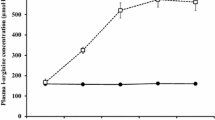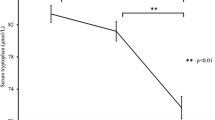Abstract
Newsholme’s theory of central fatigue suggests that acute tryptophan depletion should improve endurance exercise capacity in a warm environment by reducing serotonergic activity in the brain. Eight males cycled to volitional exhaustion at 55 % \( \dot{V}{\rm O}_{2} \) peak in 30.1 ± 0.5 °C and 30 ± 7 % relative humidity on two separate occasions, after consuming either an amino acid load to deplete their circulating tryptophan concentration (TD), or a control amino acid load (CON). Blood samples were taken before ingesting the amino acids, before the start of exercise, every 15 min during exercise and at the point of exhaustion. Heart rate (HR), core (Tc) and skin (Tsk) temperatures and ratings of perceived exertion (RPE) and thermal comfort (TC) were also monitored every 10 min during exercise. Plasma tryptophan (P = 0.003) and free tryptophan (P < 0.001) concentrations, and the free tryptophan to branched-chain amino acid ratio (P = 0.004) were all lower on the TD trial than on the CON trial. There was no difference in endurance exercise capacity (TD 99.2 ± 24.4 min as compared to CON 108.4 ± 21.6 min; P = 0.088). There was a tendency for HR (P = 0.053) and Tc (P = 0.069) to be higher on the TD trials. There were no differences for any of the other parameters. Endurance cycling capacity in a warm environment is not improved by acute tryptophan depletion, suggesting tryptophan availability is not a significant factor in the development of fatigue in such situations.



Similar content being viewed by others
References
Ahlborg BG, Bergstrom J, Brohult J, Ekelund LG, Hultamn E (1967) Human muscle glycogen content and capacity for prolonged exercise after different diets. Foersvarsmedicin 3:85–99
Alves MN, Ferrari-Auarek WM, Pinto KM, Sa KR, Viveiros JP, Pereira HA, Ribeiro AM, Rodrigues LO (1995) Effects of caffeine and tryptophan on rectal temperature, metabolism, total exercise time, rate of perceived exertion and heart rate. Braz J Med Biol Res 28:705–709
Bell C, Abrams J, Nutt D (2001) Tryptophan depletion and its implications for psychiatry. Brit J Psychiat 178:399–405
Bjork JM, Dougherty DM, Moeller FG, Cherek DR, Swann AC (1999) The effects of tryptophan depletion and loading on laboratory aggression in men: time course and a food restricted control. Psychopharmacology 142:24–30
Blomstrand E, Perrett D, Parry-Billings M, Newsholme EA (1989) Effect of sustained exercise on plasma amino acid concentrations and on 5-hydroxytryptamine metabolism in six different brain regions of the rat. Acta Physiol Scand 136:473–481
Blomstrand E, Hassmen P, Ek S, Ekblom B, Newsholme EA (1997) Influence of ingesting a solution of branched-chain amino acids on perceived exertion during exercise. Acta Physiol Scand 159:41–49
Borg GAV (1982) Psychophysical bases of perceived exertion. Med Sci Sport Exerc 14:377–381
Bridge MW, Weller AS, Rayson M, Jones DA (2003) Responses to exercise in the heat related to measures of hypothalamic serotonergic and dopaminergic function. Eur J Appl Physiol 89:451–459
Burton AC (1935) Human calorimetry II: the average temperature of tissues of the body. J Nutr 9:261–280
Chaouloff F (1989) Physical exercise and brain monoamines: a review. Acta Physiol Scand 137:1–13
Cheung SS, McLellan TM (1998) Heat acclimation, aerobic fitness, and hydration effects on tolerance during uncompensable heat stress. J Appl Physiol 84:1731–1739
Cheuvront SN, Kenefick RW, Montain SJ, Sawka MN (2010) Mechanisms of aerobic performance impairment with heat stress and dehydration. J Appl Physiol 109:1989–1995
Cooper JR, Bloom FE, Roth RH (2003) The biochemical basis of neuropharmacology. Oxford University Press, NY
Delgardo PL, Charney DS, Price LH, Aghajanian GK, Landis H, Heninger GR (1990) Serotonin function and the mechanism of antidepressant action. Reversal of antidepressant-induced remission by rapid depletion of plasma tryptophan. Arch Gen Psychiatry 47:411–418
Dill DB, Costill DL (1974) Calculation of percentage changes in volumes in blood, plasma, and red cells in dehydration. J Appl Physiol 37:247–248
Farris JW, Hinchcliff KW, McKeever KH, Lamb DR, Thompson DL (1998) Effect of tryptophan and of glucose on exercise capacity of horses. J Appl Physiol 85:807–816
Gallagher P, Massey AE, Young AH, McAllister-Williams RH (2003) Effects of acute tryptophan depletion on executive function in healthy male volunteers. BMC Psychiatry 3:10–19
Harper AE, Benevenga NJ, Wohlhueter RM (1970) Effects of ingestion of disproportionate amounts of amino acids. Physiol Rev 50:428–548
Hasegawa H, Piacentini MF, Sarre S, Michotte Y, Ishiwata T, Meeusen R (2008) Influence of brain catecholamines on the development of fatigue in exercising rats in the heat. J Physiol 586:141–149
Henderson JW, Ricker RD, Bidlingmeyer BA, Woodward C (2000) Rapid, accurate, sensitive and reproducible HPLC analysis of amino acids. Agilent Technologies
Hobson RM, Clapp EL, Watson P, Maughan RJ (2009) Exercise capacity in the heat is greater in the morning than in the evening in man. Med Sci Sport Exerc 41:174–180
Jacobs BL, Azimita EC (1992) Structure and function of the brain serotonin system. Physiol Rev 72:165–229
Jordan D (2005) Vagal control of the heart: central serotonergic (5-TH) mechanisms. Exp Physiol 90:175–181
Kellett DO, Stanford SC, Machado BH, Jordan D, Ramage AG (2005) Effect of 5-HT depletion on cardiovascular vagal reflex sensitivity in awake and anesthetized rats. Brain Res 1054:61–72
Leyton M, Young SN, Pihl RO, Etezadi S, Lauze C, Blier P, Baker GB, Benkelfat C (2000) Effects on mood of acute phenylalanine/tyrosine depletion in healthy women. Neuropsychopharmacol 22:52–63
Maughan RJ, Otani H, Watson P (2012) The influence of relative humidity on prolonged exercise capacity in a warm environment. Eur J Appl Physiol 112:2313–2321
McCloskey MS, Ben-Zeev D, Lee R, Berman ME, Caccaro EF (2009) Acute tryptophan depletion and self-injurious behavior in aggressive patients and healthy volunteers. Psychopharmacology 203:53–61
McTavish SFB, Cowen PJ, Sharp T (1999) Effect of a tyrosine-free amino acid mixture on regional brain catecholamine synthesis and release. Psychopharmacology 141:182–188
Miltner WHR, Braun CH, Coles MGH (1997) Event-related brain potentials following incorrect feedback in a time estimation task: evidence for a ‘generic’ neural system for error detection. J Cog Neurosci 9:788–798
Mittleman KD, Ricci MR, Bailey SP (1998) Branched-chain amino acids prolong exercise during heat stress in men and women. Med Sci Sport Exer 30:83–91
Morrison S, Sleivert GG, Cheung SS (2004) Passive hyperthermia reduces voluntary activation and isometric force production. Eur J Appl Physiol 91:729–736
Neumeister A, Nugent AC, Waldeck T, Geraci M, Schwarz M, Bonne O, Bain EE, Luckenbaugh DA, Herscovitch P, Charney DS, Drevets WC (2004) Neural and behavioral responses to tryptophan depletion in unmedicated patients with remitted major depressive disorder and controls. Arch Gen Psychiatry 61:765–773
Newsholme EA, Acworth IN, Blomstrand E (1987) Amino acids, brain neurotransmitters and a functional link between muscle and brain that is important in sustained exercise. In: Benzi G (ed) Advances in myochemistry. John Libbey, London, pp 127–133
Nielsen B (1992) Heat stress causes fatigue. Med Sport Sci 34:207–217
Nielsen B, Hales JRS, Strange S, Christensen NJ, Warberg J, Saltin B (1993) Human circulatory and thermoregulatory adaptations with heat acclimation and exercise in a hot, dry environment. J Physiol 460:467–485
Nybo L, Nielsen B (2001) Hyperthermia and central fatigue during prolonged exercise in humans. J Appl Physiol 91:1055–1060
Palmour RM, Ervin FR, Baker GB, Young SN (1998) An amino acid mixture deficient in phenylalanine and tyrosine reduces cerebrospinal fluid catecholamine metabolites and alcohol consumption in vervet monkeys. Psychopharmacology 136:1–7
Pardridge WM (1983) Brain metabolism: a perspective from the blood brain barrier. Physiol Rev 63:1481–1535
Ramage AG, Fozard JR (1987) Evidence that the putative 5-HT1A receptor agonists, 8-OH-DPAT and ipsapirone, have a central hypotensive action that differs from that of clonidine in anaesthetised cats. Eur J Pharmacol 138:179–191
Ramanathan NL (1964) A new weighting system for mean surface temperature of the human body. J Appl Physiol 19:531–533
Schaechter JD, Wurtman RJ (1990) Serotonin release varies with brain tryptophan levels. Brain Res 532:203-210
Schmitt JAJ, Jorissen BL, Sobezak S, van Boxtel MPJ, Hogervorst E, Deutz NEP, Riedel WJ (2000) Tryptophan depletion impairs memory consolidation but improves focussed attention in healthy young volunteers. J Psychopharmacology 14:21–29
Soares DD, Coimbra CC, Marubayashi U (2007) Tryptophan-induced central fatigue in exercising rats is related to serotonin content in preoptic area. Neurosci Lett 415:274–278
Stensrud T, Ingjer F, Holm H, Stromme SB (1992) l-tryptophan supplementation does not improve running performance. Int J Sports Med 13:481–485
Stepto NK, Shipperd BB, Hyman G, McInerney B, Pyne DB (2011) Effects of high-dose large neutral amino acid supplementation on exercise, motor skill, and mental performance in Australian rules football players. Appl Physiol Nutr Metab 36:671–681
Strachan AT, Leiper JB, Maughan RJ (2005) Serotonin2C receptor blockade and thermoregulation during exercise in the heat. Med Sci Sport Exerc 37:389–394
Struder HK, Hollmann W, Platen P, Donike M, Gotzmann A, Weber K (1998) Influence of paroxetine, branched-chain amino acids, and tyrosine on neuroendocrine system responses and fatigue in humans. Horm Metab Res 30:188–194
Van der Veen FM, Mies GW, Van der Molen MW, Evers EA (2008) Acute tryptophan depletion in healthy males attenuates phasic cardiac slowing but does not affect electro-cortical response to negative feedback. Psychopharmacology 199:255–263
Van Hall G, Raaymakers JSH, Saris WHM, Wagenmakers AJM (1995) Ingestion of branched-chain amino acids and tryptophan during sustained exercise in man: failure to affect performance. J Physiol 486:789–794
Watson P (2008) Nutrition, the brain and prolonged exercise. Eur J Sport Sci 8:87–96
Watson P, Shirreffs SM, Maughan RJ (2004) The effect of acute branched chain amino acid supplementation on prolonged exercise capacity in a warm environment. Eur J Appl Physiol 93:306–314
Watson P, Hasegawa H, Roelands B, Piacentini MF, Looverie R, Meeusen R (2005) Acute dopamine/noradrenaline reuptake inhibition enhances human exercise performance in warm, but not temperate conditions. J Physiol 565:873–883
Williams WA, Shoaf SE, Hommer D, Rawlings R, Linnoila M (1999) Cerebrospinal fluid tryptophan and 5-hydroxyindoleacetic acid in normal volunteers. J Neurochem 72:1641–1647
Williams WA, Carson RE, Momenan R, Lang L, Kerich M, Heinz A, Bjork J, Geyer C, Rawlings R, Phillips M, Johnson B, Eckelman WC, Hommer D, Herscovitch P (2002) Effects of acute plasma tryptophan depletion on serotonin receptor occupancy using PET in healthy human subjects. Neuroscience: 826–824
Wilson WM, Maughan RJ (1992) Evidence for a possible role of 5-hydroxytryptamine in the genesis of fatigue in man: administration of paroxetine, a 5-HT re-uptake inhibitor, reduces the capacity to perform prolonged exercise. Exp Physiol 77:921–924
Yildiz O, Smith JR, Purdy RE (1998) Serotonin and vasoconstrictor synergism. Life Sci 62:1723–1732
Conflict of interest
No finding was received to support this work and the authors have no conflict of interest to declare.
Author information
Authors and Affiliations
Corresponding author
Rights and permissions
About this article
Cite this article
Hobson, R.M., Watson, P. & Maughan, R.J. Acute tryptophan depletion does not improve endurance cycling capacity in a warm environment. Amino Acids 44, 983–991 (2013). https://doi.org/10.1007/s00726-012-1429-1
Received:
Accepted:
Published:
Issue Date:
DOI: https://doi.org/10.1007/s00726-012-1429-1




